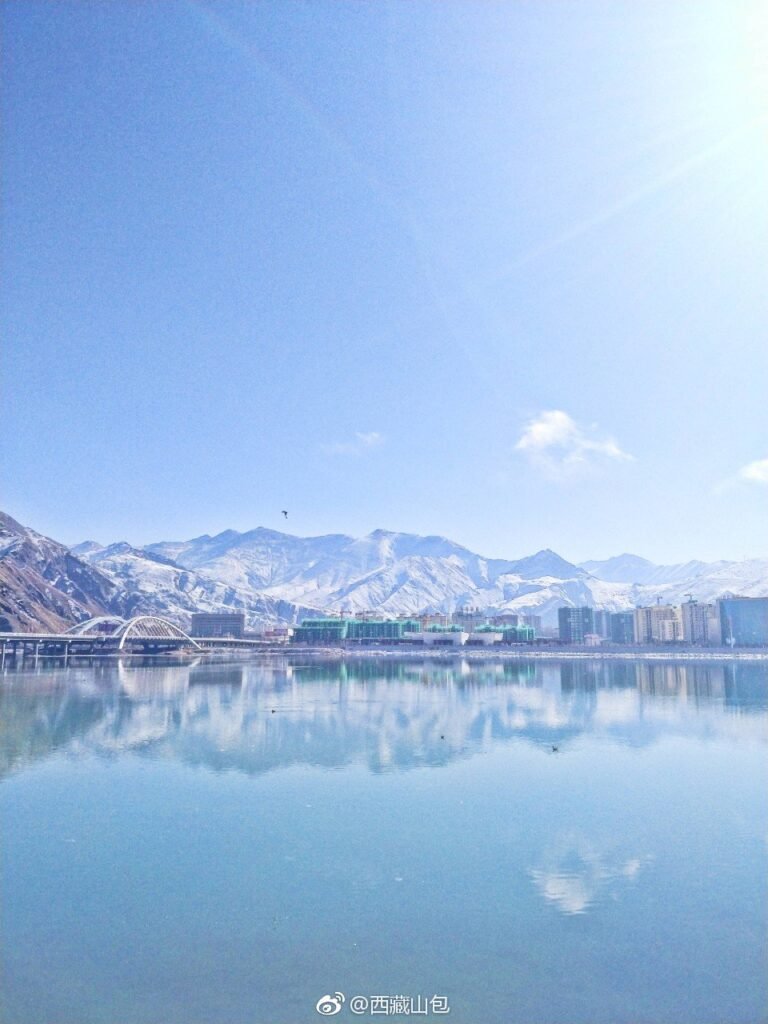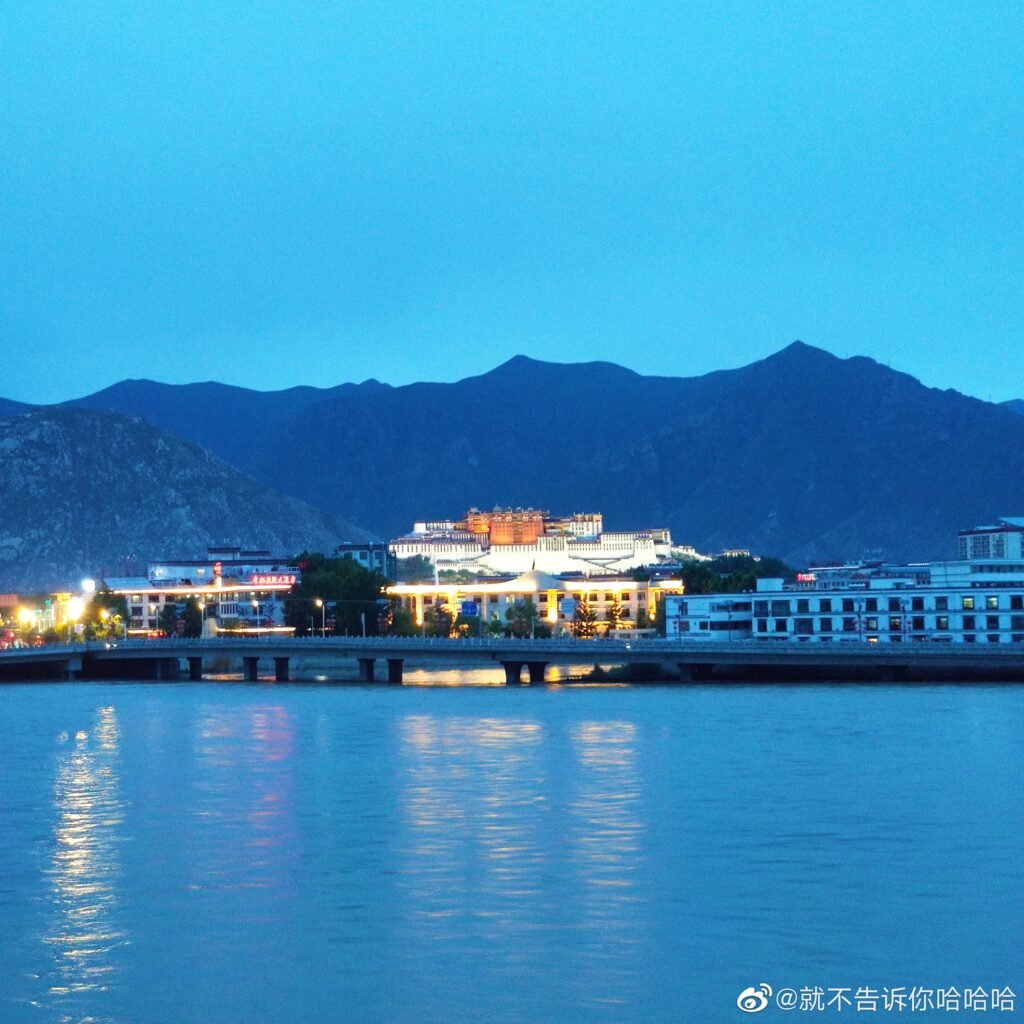The Lhasa River, known in Tibetan as “Kyichu”,(སྐྱིད་ཆུ) translates to “The Happy River” or “The River of Happiness.” It is the largest tributary of the Yarlung Tsangpo River, stretching 551 kilometers long with a drainage area of 32,471 square kilometers. Its flow rate varies dramatically with the seasons, from a minimum of 20 cubic meters per second to a maximum of 2,830 cubic meters per second, and an average flow rate of 287 cubic meters per second.
Originating from the swamps east of the Maida Basin in Nyainqêntanglha’s mid-northern slopes in Jiali County (at an elevation of 5,500 meters), the river flows through Lhünzhub, Meldro Gungkar, Dagzê, and Doilungdêqên, before joining the Yarlung Tsangpo River at Langqên Zampa in Qushui County (at an elevation of 3,580 meters), creating a stunning highland spectacle where the majestic blue and white waters meet.

A Valley of Vitality and Abundance
Upstream from Lhünzhub Tanggula, the river valley is narrow and V-shaped. As it reaches Meldro Gungkar, the valley widens, and the river channel becomes braided, with floodplains on both banks spanning 1 to 10 kilometers in width. This region, with approximately 600,000 mu (400 square kilometers) of arable land, flat terrain, abundant water resources, and a mild climate, stands as one of Tibet’s most important grain-producing areas. The river’s clean water is characterized by high levels of bicarbonate and calcium, with a total drop of 1,920 meters and an average gradient of 2.9‰.
Cultural and Natural Landscapes Along the River
The Lhasa River is flanked by numerous cultural and natural landmarks, making it a photographer’s paradise. In the southeastern part of Lhasa, a major reinforced concrete highway bridge spans the Lhasa River, part of the Sichuan-Tibet Highway. Completed in August 1965, this 520-meter-long bridge (including the approach, totaling 730 meters in length and 12 meters in width) was Lhasa’s first large-span concrete bridge, allowing two heavy trucks to pass side by side. It has played a significant role in the development of Tibet’s transportation and economy.

To the west of Lhasa, the Lhasa River is spanned by the Liuwu Railway Bridge, a 928.85-meter-long bridge with a maximum span of 108 meters. This unique double-layered, down-arched steel pipe concrete continuous arch bridge features one large and two smaller continuous arches as its main structure. Its pure white structure, reminiscent of a white khata scarf, and the main piers designed to resemble yak legs, with approach piers shaped like blooming snow lotuses on the water, create a distinctive architectural beauty that harmonizes with the Potala Palace in the distance.

The Majestic Sculpture of Lhasa: A Symbol of Ascent
At the Liuwu Bridge interchange stands a towering sculpture of a spirited horse, seemingly ready to leap into the sky. The city of Lhasa established the “Snowland Soaring” emblem in 2000 to commemorate receiving the title of “China’s Outstanding Tourist City.” However, the state discontinued the evaluation for outstanding tourist cities in 2005.
Tibet University: An Academic Beacon by the Lhasa River
Located on the eastern outskirts of Lhasa, along the banks of the Lhasa River, Tibet University was founded in 1951 and officially established on July 20, 1985. Spanning an area of 189.4 hectares, with a built-up area of 172,000 square meters and a green area of 237,000 square meters, the university boasts over 860 staff members, including more than 520 full-time teachers, of whom over 320 are Tibetan. The university comprises 11 faculties in fields such as arts, sciences, engineering, agriculture, and medicine. It offers eight master’s degree programs, including Tibetan Language and Literature, Tibetan History, and Tibetan Art, alongside 49 undergraduates and over 30 junior college specialties covering a wide range of disciplines.
Jiangsu Road: A Modern Avenue by the Lhasa River
Formerly known as Tsangdam Road and locally referred to as “Riverside Road,” Jiangsu Road stretches from the north end of Lhasa Bridge to Kang’ang Road junction, covering a distance of 3 kilometers and a width of 30 meters. This key construction project, supported by Jiangsu Province to aid Lhasa, symbolizes the unity between Tibetan and Han Chinese communities. Linking Lhasa Bridge to the Sichuan-Tibet Highway in the east and connecting to the Qinghai-Tibet and Sichuan-Tibet highway monument towards Qinghai Road, the railway station, and the airport in the west, it serves as the gateway to the western entrance of Lhasa.
Xianzu Island and Guma Linka: Leisure Spots by the Lhasa River
Xianzu Island and Guma Linka are popular destinations for Lhasa residents to enjoy their weekends or holidays. People often come in groups, bringing barley wine and butter tea, setting up tents for fishing, swimming, bathing, singing, dancing, drinking, and playing cards, making for a relaxing experience.

Visitor Tips:
- Boating on the Lhasa River: Traditional yak skin boats are a common sight on the Lhasa River. Those interested in a ride can wait at the small dock behind the “Qinghai-Tibet Sichuan-Tibet Highway Monument.”
- The snowmelt from the Nyainqêntanglha Mountains feeds the Sacred Lhasa River, which locals consider sacred and attribute eight virtues to: sweetness, coolness, softness, lightness, purity, fragrance, as well as throat-soothing and stomach-friendly qualities. They believe it clears distractions and purifies both the soul and body.
- Autumn Scenery: In autumn, the river’s green-blue waters contrast beautifully with the golden poplar trees. At sunset, the river transforms into a ribbon studded with golden sparkles, offering stunning views for photography enthusiasts.
